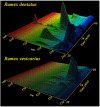Lipophilic Constituents of Rumex vesicarius L. and Rumex dentatus L
- PMID: 26784344
- PMCID: PMC4665437
- DOI: 10.3390/antiox2030167
Lipophilic Constituents of Rumex vesicarius L. and Rumex dentatus L
Abstract
Rumex dentatus L. and Rumex vesicarius L., of the family Polygonaceae, are edible herbs growing wild in Egypt. Their lipoid constituents were examined by both liquid chromatography/mass spectrometry (LC/MS) and by gas chromatography/mass spectrometry (GC/MS). Their essential oil compositions consisted mainly of thujene, limonene, fenchon, estragole, and anethole but at largely different concentration. Fatty acid compositions were similar among the two species and consisting of palmitic, oleic, linoleic and linolenic acids, with R. vesicarius containing much higher level of omega-3-fatty acids. Both of the crude lipid extracts of the two species showed strong antioxidant activity as a radical quenching agent against 2,2-diphenyl-1-picrylhydrazyl (DPPH) systems. Antioxidant activities were mostly associated with the polar lipid fractions. High performance thin layer chromatography (HPTLC), both in the normal and reversed phase,as well as liquid chromatography/mass spectrometry (LC/MS) in the positive and negative electrospray ionization (ESI), showed unique chemical profile for each species that can be useful for species identification and quality control of herbal drug formulations. R. vesicarius was characterized by abundances of flavonoids and R. dentatus was abundant in anthraquinones and chromones.
Keywords: Egypt; antioxidants; flavonoids; omega fatty acids; quinones.
Figures








References
-
- Boulos L. Flora of Egypt Checklist Revised—Annotated Edition 2009. Al Hadara Publishing; Cairo, Egypt: 2009. pp. 29–30.
-
- Abdel-Hameed E.S., El-Nahas H.A., Abo-Sedera S.A. Antischistosomal and antimicrobial activities of some Egyptian plant species. Pharm. Biol. 2008;46:626–633. doi: 10.1080/13880200802179543. - DOI
-
- Alfawaz M.A. Chemical composition of hummayd (Rumex vesicarius) grown in Saudi Arabia. J. Food Compos. Anal. 2006;19:552–555. doi: 10.1016/j.jfca.2004.09.004. - DOI
-
- Mostafa H.M., El Bakry A.A., Eman A.A. Evaluation of antibacterial and antioxidant activities of different plant parts of Rumex vesicarius L. (Polygonaceae) Int. J. Pharm. Pharm. Sci. 2011;2:109–118.
-
- Litvinenko Y.A., MuzychKina R.A. Phytochemical investigation of biologically active substances in certain Kazakhstan Rumex species. Chem. Nat. Compd. 2003;5:368–370.
Grants and funding
LinkOut - more resources
Full Text Sources
Other Literature Sources
Miscellaneous

